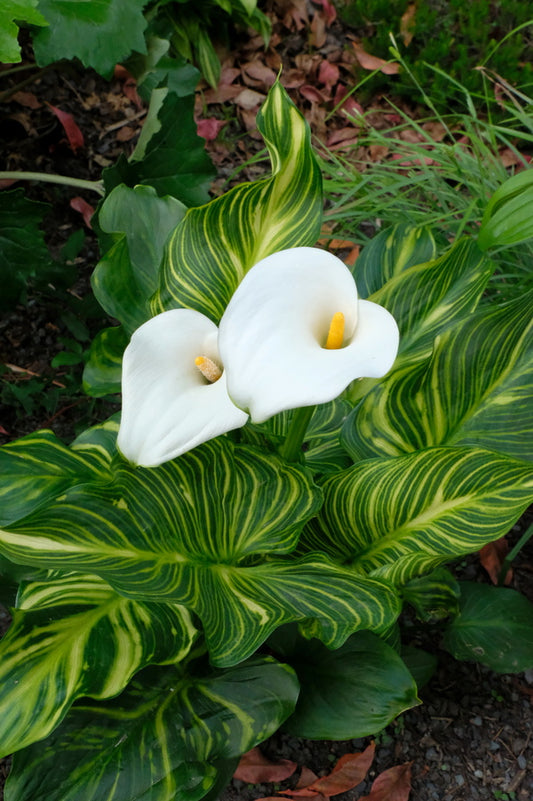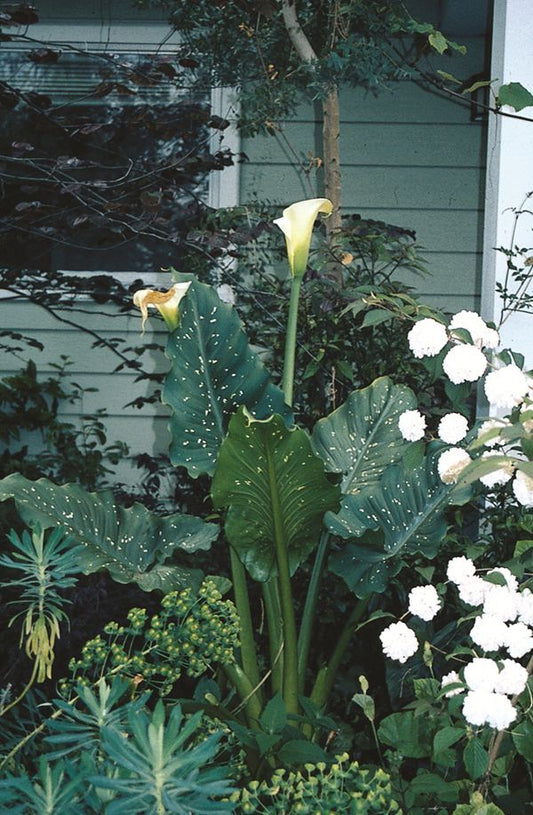We are pleased to make available some of the lesser-known Zantedeschia (calla lily) cultivars and newer hybrids, which make superb garden plants. Zantedeschia is an aroid whose attractive flowers are incredibly popular and symbolize divinity and purity, which is why calla lilies are so frequently used in weddings and funerals. White calla lilies are the most popular for cut flowers, but in the garden, bright colors are also popular including pink, yellow, orange, and purple calla lilies. Some people use the common name arum lily for Zantedeschia, but we always call them calla lilies and reserve arum lily for the genus Arum.
-
Zantedeschia aethiopica 'African Gold'
Item #: 13443
Zones: 8b to 10b, guessing
Dormancy: Summer, Fall
Height: 24" tall
Culture: Sun to Part Sun
Origin: South Africa
Pot Size: 3.5" pot (24 fl. oz/0.7 L)
Regular price $36.00Regular priceUnit price per -
Zantedeschia aethiopica 'White Giant'
Item #: 3695
Zones: 7a to 10b
Dormancy: Summer, Fall
Height: 72" tall
Culture: Sun to Part Sun
Origin: South Africa
Pot Size: 3.5" pot (24 fl. oz/0.7 L)
Regular price $30.00Regular priceUnit price per -
 Sold out
Sold outZantedeschia 'Frozen Queen'
Item #: 18527
Zones: 7b to 10b, at least
Dormancy: Winter, Fall
Height: 18" tall
Culture: Part Sun
Origin: Hybrid
Pot Size: Bare Root / 3.5" pot (24 fl. oz/0.7 L)
Regular price $25.00Regular priceUnit price per -
Zantedeschia 'Picasso'
Item #: 8324
Zones: 7b to 10b, at least
Dormancy: Winter, Fall
Height: 30" tall
Culture: Part Sun
Origin: Hybrid
Pot Size: Bare Root / 3.5" pot (24 fl. oz/0.7 L)
Regular price $22.00Regular priceUnit price per
More Information About Zantedeschia
Calla Lilies are not actually lilies but are part of the Araceae family, also known as aroids. Zantedeschia aethiopica is the most grown species of calla lily, but many florist calla lilies are hybrids with other Calla species bringing in traits such as spotted leaves and an array of colorful flowers such as purple, red, pink, orange and yellow. At Plant Delights, we are always trialing new varieties of calla lilies for sale both in our nursery and at the JLBG gardens and we think you will really appreciate the calla lily selections we have chosen to release to the public this year.
How to Grow and Care for Calla Lilies
Where to Plant Zantedeschia
Zantedeschia aethiopica is a natural bog plant and makes a great pond marginal or rain garden plant in southern climates. Basically, if you have a wsater feature in your garden, calla lilies are a great choice. When planting in the garden, be sure to cover the rhizomes with about 2-4 in. (5-10 cm) of soil and space about 12-18 in. (30-45 cm) apart.
Calla lilies also make great container plants since they are one of the few house plants that can thrive in overly wet potting soil. A great choice for those of us who tend to forget when we last watered! Container planting also allows you to safely overwinter your plant indoors if you are in a zone with more extreme winters.
Call Lily Winter Hardiness
The calla lilies offered at Plant Delights are considered hardy tropical plants that can typically survive winter conditions in Zones 7a to 8 and may survive more severe winters with some protection. In areas where the temps are too low, you can dig up your calla lilies and store in lightly moistened peat through the winter. If you live in a northern climate, consider planting in a container so that your calla lily can easily be brought indoors when the temperature starts to drop.
Typical Zantedeschia aethiopica Bloom Time
Most of the colored-flowered callas bloom in summer. The white-flowered Zantedeschia aethiopica flowers in late winter/early spring. If your callas are not blooming it could be due to lack of sun or too little water.
Dormancy
Gardeners should be patient with their calla lilies. While the white-flowered Zantedeschia aethiopica is a winter grower and will start to grow as soon as the weather warms up, other species of calla lilies are winter dormant and usually don't wake up from their winter dormancy until May or June.
Propagating Calla Lilies
Calla Lilies can be propagated using seeds or by division of the rhizomes during their growing season. Just keep in mind that calla lilies will not come true from seed, and to keep the desirable traits, they must be done from rhizome divisions.
Water and Soil Requirements
In the wild, Zantedeschia aethiopica grow in marshy, bog-like conditions so they can tolerate moist garden sites if winter drainage is adequate. Even though calla lilies thrive best in moist, well-drained soil, they are amazingly durable under less-than-ideal conditions. In general, though, more water equals more flowers. Other calla lily species and their hybrids, Z. albomaculata, Z. elliotiana, Z. rehmannii, are not naturally bog plants and instead prefer drier, more typical soil conditions.
Calla Lily Bulbs
Calla lily bulbs should be planted somewhat shallow, about 2-4 in. (5-10 cm.) deep. They have contractile roots that will draw the calla bulb down to its preferred depth. It’s safe to plant your bulbs 12-18 in. (30-45 cm.) apart in the spring once any threat of frost has passed.
Light Requirements
Calla lilies prefer full sun but if you are in a hotter climate such as the southern US, then partial shade is fine. If your calla lily lives in a pot, then take it outside during the spring and summer months and let it soak up the sun.
Pests and Diseases
Calla lilies are resistant to most mammalian pests including deer and rabbits. The rhizomes are susceptible to rot if the soil does not have adequate drainage.
Toxicity
Calla lilies contain calcium oxalate which is poisonous to humans, cats, dogs, and horses. Avoid ingesting the flowers, leaves, roots, stems, or sap and wear protective clothing when pruning since the sap can cause contact dermatitis.
Be sure to check out Tony’s many calla lily blog posts over at the JLBG.org blog.






